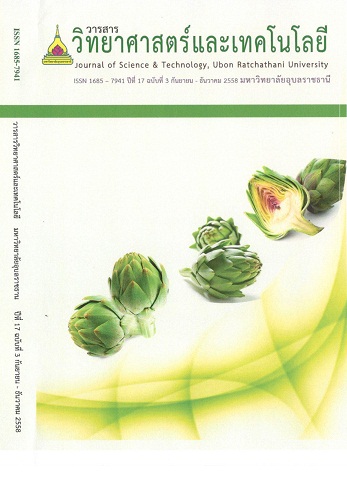Photo-stabilization of Sappanwood Ethanolic Extract with Ammonium Alum Chelation
Main Article Content
บทคัดย่อ
Phenolic compounds are well-known as active ingredients in herbal extracts. Normally, they are degraded when exposed to light, which decreases their biological activities. To improve their photo-stability, combination with chelating agents is required to prevent photo-oxidation. This study aimed to use ammonium alum to slow the photo-degradation of sappanwood ethanolic extract (SE). Before the examination, SE was dissolved in a solution of ammonium alum, ethanol, and PBS pH 7.4. After incubation under light and dark conditions at room temperature for 48 h, the solutions were measured to show a photo-absorbance of between 200 to 700 nm. The results revealed that the addition of ammonium alum into SE solutions caused a sudden decrease in the photo-absorbance at 541 nm (PS541) from 3.010 to 2.226 (26.56%) and presented a new peak at 573 nm. Moreover, when unchelated SE solution was maintained under dark conditions for 24 h and 48 h, their PS541 decreased greatly from 3.010 to 0.979 (67.48%) and from 3.010 to 0.446 (85.18%) respectively. When the unchelated SE solution was incubated under light conditions for 24 h and 48 h, their PS541 decreased even more from 3.010 to 0.667 (77.84%) and from 3.010 to 0.282 (90.62%) respectively. However, when the chelated SE solution was incubated under light conditions for 24 h and 48 h, their PS541 was decreased slightly from 2.226 to 1.908 (14.28%) and from 2.226 to 1.200 (46.10%) respectively. For the incubation in dark conditions, the PS54 of the chelated SE solution incubated for 24 h slightly increased from 2.226 to 2.289 (2.82%) while 48 h incubation caused a decrease from 2.226 to 1.371 (38.42%). It can be concluded that ammonium alum chelation stabilized SE for at least 24 h under dark conditions. This finding can be used to improve the photo-stability of herbal products in future studies.
สารประกอบฟีนอลิค เป็นที่รู้จักกันดีว่าเป็นสารออกฤทธิ์ที่อยู่ในสารสกัดสมุนไพร โดยปกติแล้ว สารเหล่านี้สามารถสลายได้เมื่อถูกแสง ซึ่งจะทำให้ฤทธิ์ทางชีวภาพของสารนั้นลดลง เพื่อเป็นการเพิ่มความเสถียรต่อแสงให้กับสาร ต้องนำมาทำปฏิกิริยากับสารคีเลตเพื่อป้องการถูกออกซิไดซ์ด้วยแสง งานวิจัยนี้จึงมุ่งเน้นในการใช้แอมโมเนียมอะลัมเพื่อลดการสลายตัวของสารสกัดจากแก่นฝางด้วยแสง ในการศึกษานี้ สารสกัดจากแก่นฝางจะถูกละลายในสารละลายที่ประกอบด้วย แอมโมเนียมอะลัมเอธานอล และฟอสเฟตบัฟเฟอร์ซาลีน พีเอช 7.4 จากนั้นนำไปวางไว้ในห้องที่มีแสงและไม่มีแสงที่อุณหภูมิห้อง เป็นเวลา 48 ชั่วโมง แล้วนำสารละลายดังกล่าวไปวัดค่าการดูดกลืนแสงระหว่าง 200-700 นาโนเมตร จากการศึกษาพบว่า สารละลายที่เติมแอมโมเนียมอะลัม จะมีค่าการดูดกลืนแสงที่ 541 นาโนเมตร ลดลง จาก 3.010 เป็น 2.226 (26.56%) และมีการปรากฏของพีคที่ 573 นาโนเมตร เพิ่มขึ้นมา ในการศึกษาสารละลายที่ไม่ได้ใส่แอมโมเนียมอะลัมและเก็บในที่มืดเป็นเวลา 24 และ 48 ชั่วโมง พบว่า ค่าการดูดกลืนแสงที่ 541 นาโนเมตร ลดลง จาก 3.010 เป็น 0.979 (67.48%) และจาก 3.010 เป็น 0.446 (85.18%) ตามลำดับ ในทางตรงกันข้าม สารละลายที่ไม่ได้ใส่แอมโมเนียมอะลัมและเก็บในที่มีแสงเป็นเวลา 24 และ 48 ชั่วโมง พบว่า ค่าการดูดกลืนแสงที่ 541 นาโนเมตร จะลดลง จาก 3.010 เป็น 0.667 (77.84%) และจาก 3.010 เป็น 0.282 (90.62%) ตามลำดับ ทั้งนี้ เมื่อสารละลายที่มีการใส่แอมโมเนียมอะลัมและเก็บไว้ที่มีแสงเป็นเวลา 24 และ 48 ชั่วโมง พบว่า ค่าการดูดกลืนแสงที่ 541 นาโนเมตร จะลดลงเล็กน้อย จาก 2.226 เป็น 1.908 (14.28%) และจาก 2.226 เป็น 1.200 (46.10%) ตามลำดับ สำหรับการเก็บสารละลายที่มีแอมโมเนียมอะลัมในที่มืดเป็นเวลา 24 ชั่วโมง พบว่า ค่าการดูดกลืนแสงที่ 541 นาโนเมตร เพิ่มขึ้นเล็กน้อย จาก 2.226 เป็น 2.289 (2.82%) ในขณะที่การเก็บไว้เป็นเวลา 48 ชั่วโมง จะมีค่าการดูดกลืนแสงลดลง จาก 2.226 เป็น 1.371 (38.42%) จากการศึกษาสามารถสรุปได้ว่า การเติมแอมโมเนียมอะลัมลงในสารละลายสารสกัดจากแก่นฝาง จะช่วยคงสภาพสารละลายสารสกัดจากแก่นฝางที่เก็บในที่มืด อย่างน้อยเป็นเวลา 24 ชั่วโมง การค้นพบนี้ สามารถช่วยเพิ่มความเสถียรของผลิตภัณฑ์จากสมุนไพรได้ในอนาคต
Article Details
บทความที่ได้รับการตีพิมพ์เป็นลิขสิทธิ์ของ วารสารวิทยาศาสตร์และเทคโนโลยี มหาวิทยาลัยอุบลราชธานี
ข้อความที่ปรากฏในบทความแต่ละเรื่องในวารสารวิชาการเล่มนี้เป็นความคิดเห็นส่วนตัวของผู้เขียนแต่ละท่านไม่เกี่ยวข้องกับมหาวิทยาลัยอุบลราชธานี และคณาจารย์ท่านอื่นๆในมหาวิทยาลัยฯ แต่อย่างใด ความรับผิดชอบองค์ประกอบทั้งหมดของบทความแต่ละเรื่องเป็นของผู้เขียนแต่ละท่าน หากมีความผิดพลาดใดๆ ผู้เขียนแต่ละท่านจะรับผิดชอบบทความของตนเองแต่ผู้เดียว


